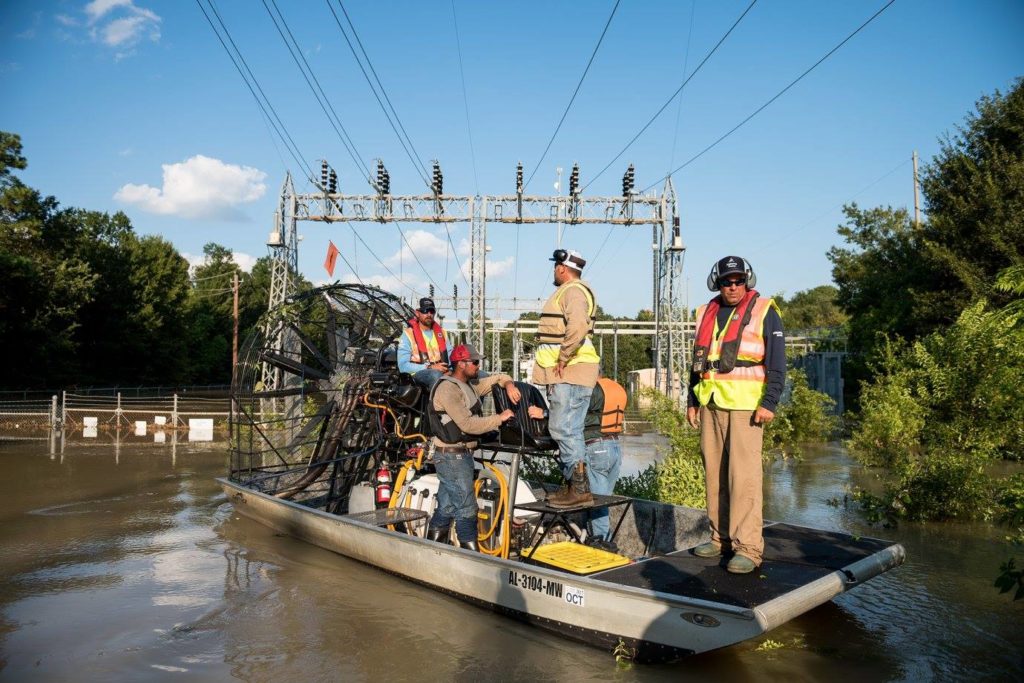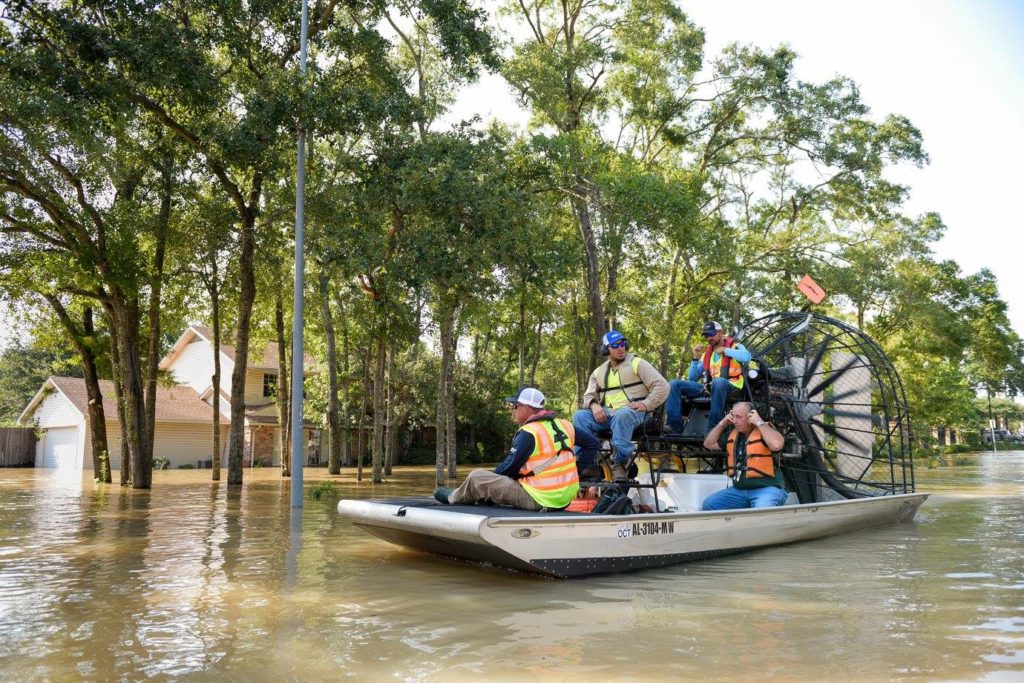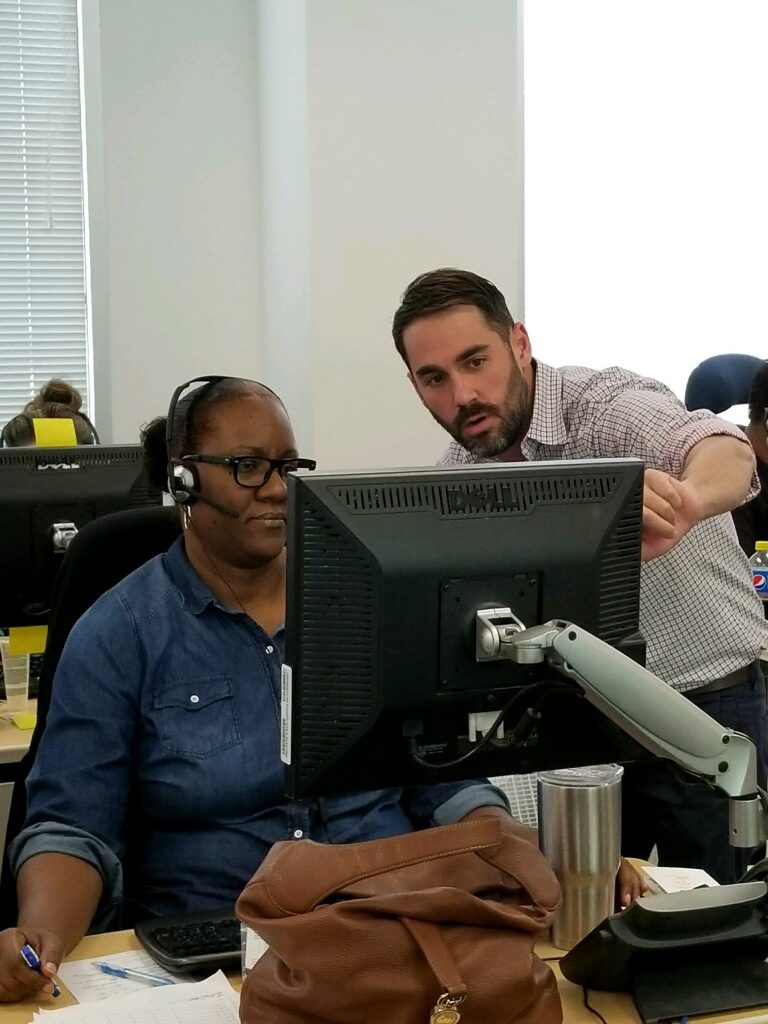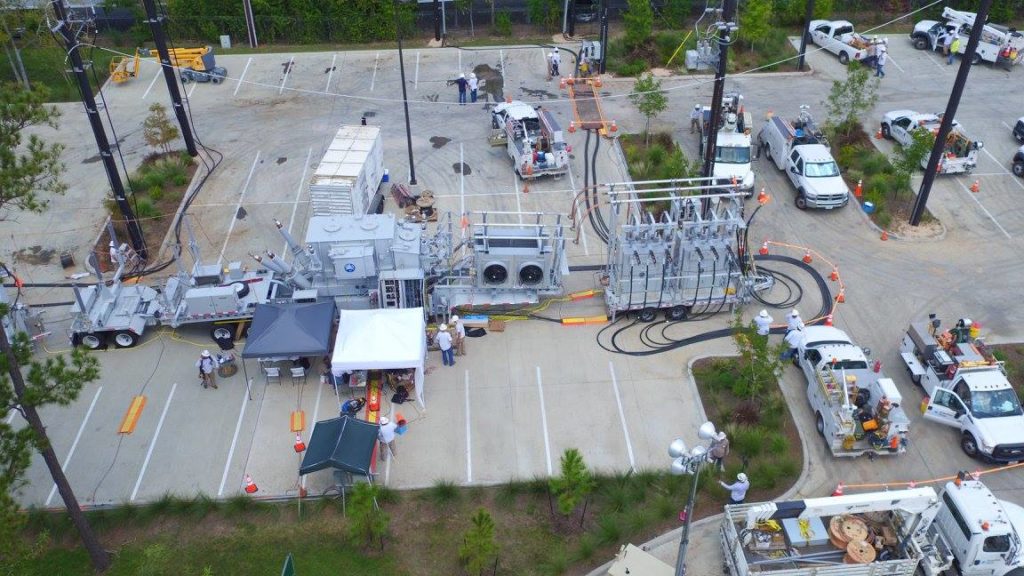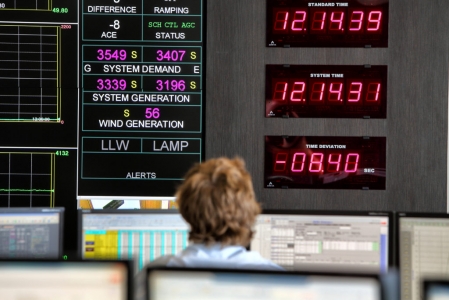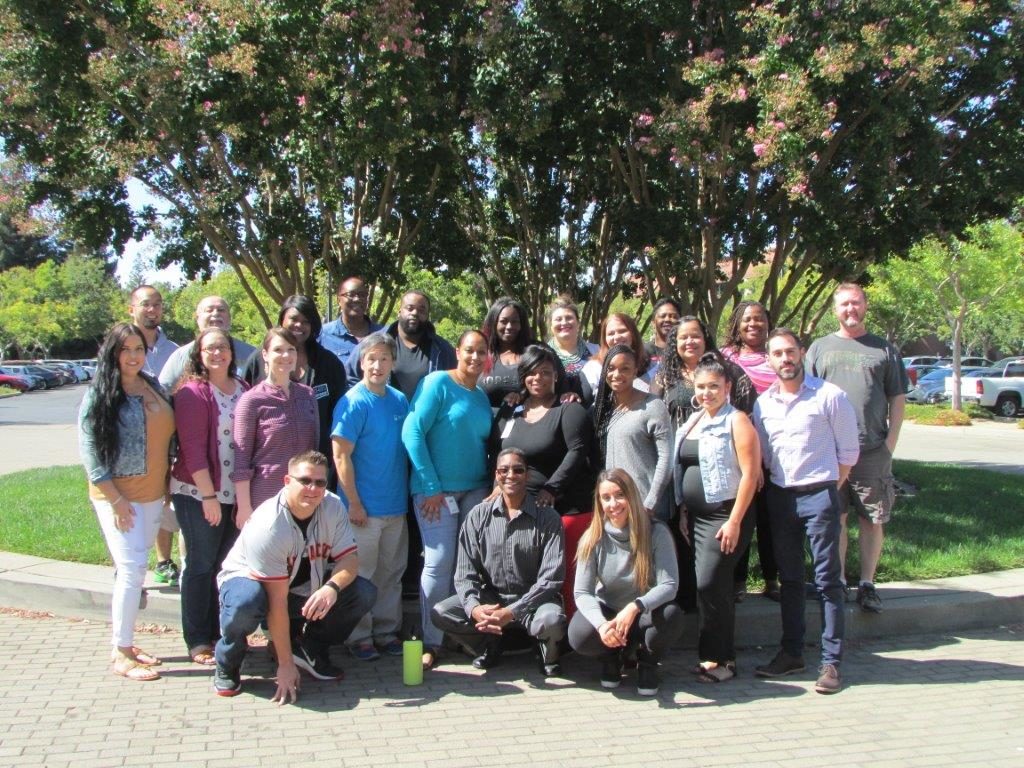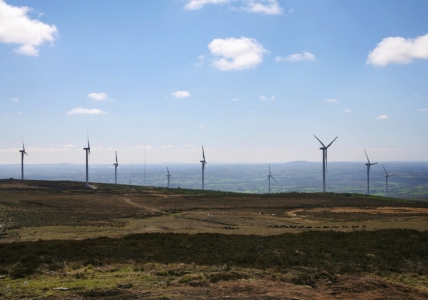Mobile Substations, Cross-Country Customer Support, Wind Farms, and Other Success Stories from the 2017 Hurricanes
In just three days, Hurricane Harvey dumped 51 inches of rain on Houston in late August 2017, flooding a third of the city. Crews from local utility CenterPoint Energy deployed dozens of air boats, amphibious vehicles, and drones to survey the damage. Overflow from two levies flooded a substation in the Spring Branch district, and the crews needed a quick solution to restore power.
“We were near George Bush Park, which had never flooded like that before, when we found a church parking lot that was above water,” said Taylor Stuckey, CenterPoint construction and quality assurance coordinator. “It was the perfect spot to put a mobile substation because it was near the flooded one.”
With the blessing of a priest at the church, CenterPoint placed its Memorial Mobile Substation on the property to serve residents and businesses while the permanent substation was restored.
“We set up temporary transmission and distribution poles and rerouted the power around the existing substation,” said Kenny Mercado, CenterPoint senior vice president for electric operations. “The mobile substation has operated for more than seven months while CenterPoint rebuilds and upgrades the substation.”
According to Mercado, mobile substations have been part of CenterPoint’s resiliency strategy for years. The utility keeps them on hand for natural disasters and other circumstances.
“If we’re building a substation and the load is growing quickly, we will bring in a mobile substation until we can complete the construction,” he said.
The value of mobile substations is among dozens of lessons and insights to emerge from electric utilities’ response to deadly 2017 hurricanes. At an EPRI Research Advisory Committee meeting last October, utility executives discussed their hurricane response in detail and compared notes on different approaches.
“We brought together people with a variety of experiences and perspectives to share what they’ve learned, ask questions, and explore how to move forward as an industry,” said EPRI Senior Project Manager Robin Bedilion.
This article discusses the experiences of three companies: CenterPoint, Pacific Gas & Electric (PG&E), and EirGrid.
CenterPoint: Digital Technologies in Action
More than a million CenterPoint customers lost power because of Hurricane Harvey. CenterPoint’s response relied on 2,200 employees, 1,500 contractors, and mutual assistance from seven states for a total of more than 350,000 hours.
Mercado said that his company’s Intelligent Grid technology avoided more than 40 million outage minutes during Hurricane Harvey. Hundreds of power line monitoring devices, remote switches, smart meters, and other automation equipment helped crews locate outages and speed repairs.
“It gave us a faster start,” said Mercado. “When you digitize your grid, you see things in real time that you never could see before. It allows us to efficiently monitor our system for real problems, prioritize our resources, and efficiently recover from our damages. It also allows us to prepare for communications with customers and other stakeholders.”
“Digital smart metering was probably the most important advancement. It worked incredibly well,” he said. “We were able to use the remote capabilities of meters even when the streets were flooded and not passable. The meters enabled us to communicate with customers about outage conditions during and after the storm. We were reading meters, turning them back on, and getting lights back on.”
Fifteen drones were equipped to assess damage and provide information on working conditions facing crews at hundreds of locations—from flooding to broken poles to downed wires. The drones’ infrared sensors helped to identify weakened or damaged power lines and equipment requiring further inspection.
CenterPoint’s Power Alert Service provided customers with text and email updates on outages and estimated restoration times. The utility also used Facebook, Instagram, and other social media to communicate with customers.
“We were well-prepared and well-drilled,” said Mercado. “We understood our roles and responsibilities. Our Incident Command Structure worked very well.”
PG&E: Customer Service for Florida Power & Light
During natural disasters, utilities’ mutual assistance programs help them restore customers’ electric service quickly and safely. On September 8, 2017, as Hurricane Irma approached Florida, PG&E sent crews to assist Florida Power & Light (FPL) with grid restoration. After the hurricane made landfall a few days later, PG&E received an unusual request.
“We were on a call with FPL leadership, and we asked if there was anything we could do to help out on the customer side,” recalled Chris Zenner, who directs PG&E’s Residential Customer Team. “They asked if we could take customer calls.”
This had never been done before, but PG&E accepted the challenge, enlisting its IT department to brainstorm a solution.
“We converted a training room in our Sacramento customer contact center into an FPL call center,” said Zenner. “We wiped the PG&E software off the computers and installed FPL software.”
FPL had to ship virtual private network (VPN) tokens to enable PG&E call-takers to access the Florida utility’s real-time outage information. PG&E’s IT team worked with FPL to troubleshoot technical problems.
“We asked for volunteers because we knew they were going to have to work weekends,” said Zenner. “We received an overwhelming response—more than we needed.”
On September 15, an FPL trainer flew to Sacramento and oriented PG&E’s 22 volunteers, with support from PG&E trainers. “The volunteers were ready to take calls the next day,” he said.
From September 16–22, they responded to more than 4,650 customer calls, with the utility’s IT team assisting as needed.
“A lot of the customers had been without power for many days,” Zenner added. “Many of the calls were about wires down. Customers were asking, ‘When are you coming out?’”
PG&E call-takers responded to customer inquiries using FPL’s real-time outage data.
“With mutual assistance, we often think of sending crews to restore power,” Zenner said. “But how do you help with customer support? It was important to get the right people involved from the beginning—the people who can make the important decisions. That was the biggest lesson learned. On day one, we didn’t have the right decision makers in the room, but by day two, we did.”
PG&E developed an effective process for handling outage calls for another utility. This included setting up computers, assembling and training staff, and resolving IT issues. The experience also pointed to the importance of deploying IT and training personnel as early as possible.
“In the future, if hurricanes are forecast and we offer to help with customer calls, we’re going to have a trainer fly out here early and have PG&E staff positioned so that we’re ready to go on day one,” Zenner said.
EirGrid: Wielding Ophelia’s Wind
On October 16, 2017, tropical storm Ophelia hit southwest Ireland with record-breaking winds.
A concern for transmission grid operator EirGrid was managing Ireland’s significant wind power capacity before, during, and after the storm’s winds hit the island. At high wind speeds, wind turbines automatically shut down to prevent damage—and a sudden, large loss of generation can adversely impact grid balance. EirGrid’s National Control Centres can control most of the country’s wind farms remotely. Before the storm made landfall, the centers preemptively curtailed more than a gigawatt of wind capacity in southwest Ireland (about 25% of the country’s total installed wind capacity). As the storm moved across the island, wind turbine curtailments were lifted in the south and applied in northern regions. Grid operators ramped up reserve generation from conventional power plants to balance the system’s production and demand.
They also needed to anticipate system demand. System load was lower than normal because of distribution system faults and industry and school shutdowns. This resulted in high voltage in some parts of the transmission system, which EirGrid staff successfully mitigated using the wind farms’ voltage control capabilities.
“A big insight from Ophelia relates to the use of renewables during extreme weather,” said EPRI Technical Leader Adrian Kelly. “It is essential that remote control is available to control renewable energy resources. With remote control, EirGrid could accommodate significant wind generation even at high wind speeds. Curtailing wind generation just before storm landfall helped to avoid a sudden loss of energy. EirGrid then used the curtailed wind energy to balance the system and navigate demand forecast uncertainty. Grid operators also used wind farms to control transmission system voltage.”
Communication was integral to EirGrid’s response. The company’s Emergency Communications Team held 12 meetings on the day of the storm to discuss weather, system status, and staffing. With more operators than normal in the control centers, it was critical to define roles and authority clearly.
Resiliency Research at EPRI
EPRI research initiatives to enhance grid resiliency and recovery during and after major storms include:
- Drone inspections for storm response. Surveying field experience, identifying the value and limitations, field-testing technologies, and informing decisions for specification, acquisition, and application of technologies.
- Tool for prioritizing resiliency investments. Developing a tool that enables utilities to estimate the reduction in outage risk per dollar spent for a given resiliency strategy.
- Overhead distribution design for resiliency and reliability. Identifying, testing, and refining resilient designs for overhead structures.
- Role of microgrids and advanced energy communities in resiliency. This includes work with the U.S. Department of Energy and the California Energy Commission.
“We must continue to develop the research and technologies to make responses to these events even more effective and efficient,” said EPRI’s Bedilion. “An important takeaway from our October meeting was that addressing these issues requires continuing the spirit of cooperation and collaboration among our utility members.”
Key EPRI Technical Experts:
Robin Bedilion, Adrian Kelly, John Tripolitis, Dexter Lewis, Arindam Maitra
For more information, contact techexpert@eprijournal.com.
Artwork by James Provost

